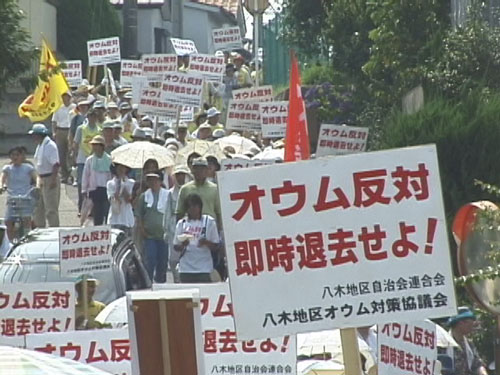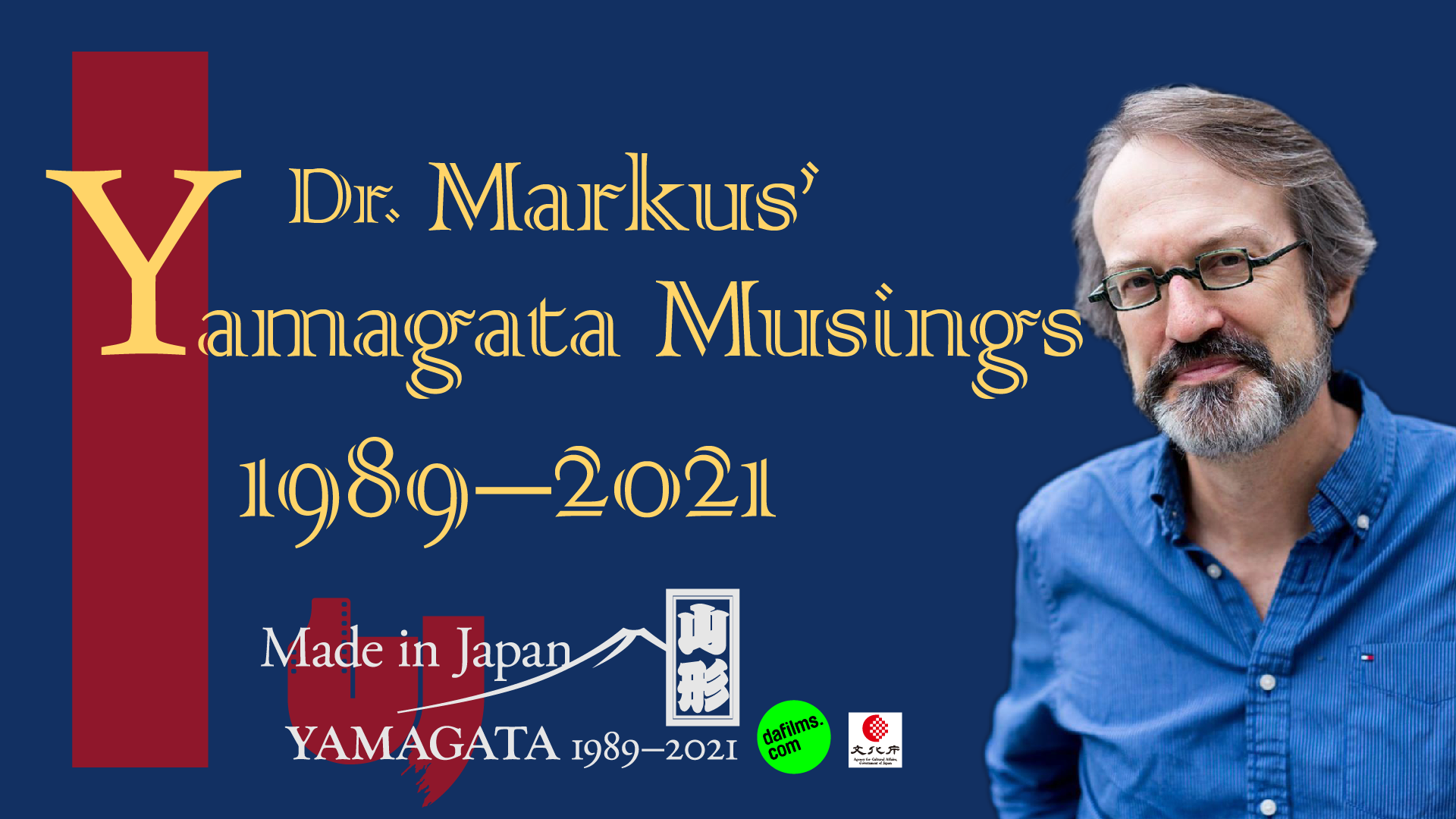On March 20, 1995, as preparations for that October’s Yamagata International Documentary Film Festival were picking up, Japan was rocked by domestic terrorism. Five members of the Aum Shinrikyo religious cult broke bags of sarin in Tokyo subway trains. The stations under attack were just kilometers away from the Yamagata Tokyo office in Kagurazaka and in every direction. Fourteen people died, over 5,000 victims went to hospitals, and things got strange fast. I vividly recall the way daily life transformed that spring and summer. Commuting to and from the festival office, one accumulated all sorts of trash in one’s pocket because all the trashcans in Tokyo had been taped shut. There was a general sense of fear, particularly because of the hyperbolic way the media portrayed both the manhunt and the cult itself.
It was all incredibly dramatic and I wondered if any intrepid filmmakers were pursuing the story. My question was answered three years later with Mori Tatsuya’s A (1998), which he followed up in 2001 with A2. Mori’s films are a variation of direct cinema. He follows the media frenzy around the cult with his camcorder, occasionally inserting himself into the scenes with questions. Once in a while, he offers his perspective on things. The reception of the films, particularly the first one, was real surprise. Somehow, Mori had insinuated himself into the good graces of the Aum leadership and he offered Japanese audiences a glimpse at the inside workings of the organization under police and media siege. The films raise a wide array of questions about both the workings and beliefs of the cult and the patently unethical behavior of both the authorities and the media. From this starting point, Mori built a career around questions of documentary and journalistic ethics.

Incredibly, I’ve heard Mori Tatsuya downplay his work as a documentary filmmaker. True, the man has written upwards of 40 books, and is a regular commentator on television any time journalistic ethics come to the fore. However, his contributions to Japanese documentary are undeniable, and A2 (2001) is as good a starting point as any for approaching his oeuvre.
Mori went to Rikkyo University, where he connected with a cohort of film-crazy students that included Kurosawa Kiyoshi. He even had an acting role in few of Kurosawa’s first films. Around the same time, he pursued a career in television journalism; however, he continually found the strictures of mainstream tv not only unbearably tight, but at times sketchy to boot.
This came to a head during the Aum Shinrikyo subway attack. In the year after the attack Mori had a line on Aum’s media spokesperson, Araki Hiroshi, and was able to conduct extensive interviews on tape. He wanted to use these as the basis for some television documentary, but the producers only wanted to extract his interviews and embed them in the conventional, hyperbolic coverage of the day. Frustrated, he teamed up with producer Yasuoka Takahara, who started his career as assistant director to Hara Kazuo on The Emperor’s Naked Army Marches On (Yuki yukite shingun, 1987), and they edited the film into a feature length documentary entitled, simply A.
It was a hard time to distribute independent documentaries. The postwar network of independent screening venues and groups was transforming into a nationwide collection of independently run theaters, or “mini-theaters.” They were few and far between, and they weren’t showing much non-fiction.
There was a technical obstacle as well. This was still the transition era between film and video. Here is a telling example: festival regular Jon Jost was just turning to—and proselytizing—digital capture and submitted his fully digital London Brief (1999) to Yamagata around the same time Mori completed A. The festival accepted the film to the competition…and told him to transfer it to film, as per the regulations. Jost said he didn’t have the $30,000 that would take, but the festival obstinately refused to budge (the film was finally shown out of competition and won an award). This is one reason A was shown out of competition at the 1997 YIDFF.
Mori and Yasuoka were up against this deeply held prejudice against video. A and A2 are rough and ready. They almost exclusively hand-held—poorly—with the occasional wind blowing out the soundtrack. Lighting is often muddy. Resolution is so low it looks somewhat fuzzy from start to finish. As a result, A has been seen more in the intervening years than its original run. A2 fared better in 2001. Yamagata had broken down by then and started accepting video submissions without the expectation of a film transfer. The film was selected for the international competition and picked up two awards that October.
The films were electrifying for those who took them on the terms of the new technology and its protean conventions. Mori freely traverses the border between the inner Aum sanctum and the crazy media ecosystem outside. This is literalized over and over in the films during press conferences. While the media mob waits in their assigned seats—cameras lined up and pens at the ready—Mori’s camera effortlessly moves to adjacent spaces where the Aum leadership prepares to meet the press. We then see how television repackages that raw reality and inevitably spins it in ways unfair to the cult. At the same time, while Mori portrays the Aum members sympathetically, he hardly lets them off the hook. He masterfully walks these lines and in an ethnically righteous manner.


To this, Mori adds regular Japanese to the mix in A2. The film careens between encounters between Aum and three groups: the police, rowdy right-wing nationalists, and Japanese citizens living in the communities Aum has set up shop in. A2 picks up around the beginning of the new century and captures a turning point in the story. Public relations head Joyu Fumihiro is let out of prison and replaces Asahara Shoko’s sons as the leader. The group changes its name to Aleph, and announces doctrinal changes. They apologize and create a large fund to compensate victims. At the same time, the government passes an anti-Aum law that allows the authorities extraordinary surveillance power. And at Aum’s facilities around the country, community members organize 24-hour surveillance posts and subject cult members to searches.
Mori’s film tracks all these developments from inside the compounds and offices. The hysteria and discrimination members are subjected to is striking, especially thanks to the director’s humanizing gaze. He remains critical and repeatedly challenges his subjects. But he’s also respectful and friendly. Likewise, as the citizen surveillance teams interact with cult members over time, they realize how unfair the global demonization has been and begin to establish friendships. That leaves the ultra-right activists, the police and the media, none of whom shows any capacity to learn or change.
Since the turn of the century, Mori went on to write dozens of books on the complex themes raised by A and A2. He addresses human rights, the legal foundations and cultural challenges of freedom of religion and speech, and the ethical quandaries of journalistic practice. Several of his books powerfully explore the theoretical dimensions of documentary and truth claims. These are themes he has returned to in his most recent must-see documentaries FAKE (2016) and i-Documentary of the Journalist (2019). To understand what he aspires to in these films, one ideally approaches them through Mori’s own starting point, the epicenter of the media spectacle captured in A2.

Markus Nornes is Professor of Asian Cinema at the University of Michigan, where he specializes in Japanese film, documentary and translation theory. He was a programmer at YIDFF in the 1990s and beyond, and has also made films. His current book, the open access Brushed in Light, is on the intimate relationship of calligraphy and East Asian cinema.
http://www-personal.umich.edu/~nornes
Dr. Markus’ Yamagata Musings
(1) A Movie Capital Dir: Iizuka Toshio / 1991 / YIDFF ’91 Special Invitation
(2) Living on the River Agano Dir: Sato Makoto / 1992 / YIDFF ’93 Award of Excellence
(4) Pickles and Komian Club Dir: Sato Koichi / 2021 / YIDFF 2021 Yamagata and Film
(5) The New God Dir: Tsuchiya Yutaka / 1999 / YIDFF ’99 New Asian Currents
(6-final) Storytellers Dirs: Sakai Ko, Hamaguchi Ryusuke / 2013 / YIDFF 2013 SkyPerfectTV IDEHA Prize
![ドキュ山ライブ! [DOCU-YAMA LIVE!]](http://www.yidff-live.info/wp-content/themes/yidff-live_2017/images/header_sp_logo1.png)

